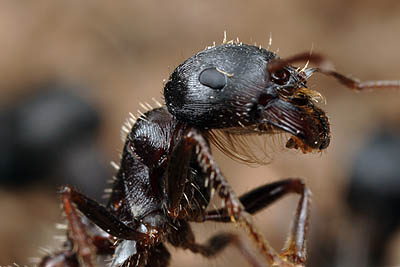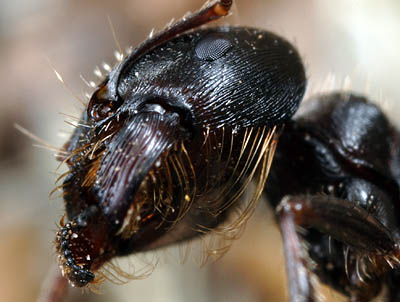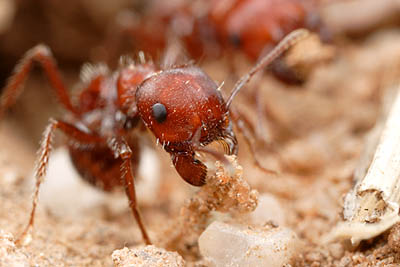
In our front yard we've got a busy nest of Pogonomyrmex rugosus seed harvesting ants. Warming weather brought them out for the first time last week, and every now and again I go out to see what they're up to. Lots of digging, it seems.
Pogonomyrmex is greek for "Bearded Ant", named 150 years ago by Austrian myrmecologist Gustav Mayr for the thick brush of hairs on the underside of the head. Entomologists affectionately refer to these ubiquitous desert insects as "Pogos". What does the beard do?
It's a construction tool, and one that is especially helpful in dry, sandy climates. As anyone who has made sand castles can attest, dry sand doesn't clump, it just falls apart. In contrast, wet sand is easy to carry. The grains stick together and can be carried about as a big clump, like this. Desert ants don't have the luxury of wet sand for most of the year. They've had to improvise, and what they came up with is the beard, or psammophore. It's a little basket on the underside of the head made of stiff hairs.

We have a different harvester ant species out the back, the smaller P. desertorum. Like most Pogonomyrmex they also have a well-developed psammophore. I took a series of psammophore action shots over the weekend as workers diligently carried bits of excavated soil out of their nest. (This was easier than shooting the rough harvesters. The mellower P. desertorum is much, much less inclined to sting nosy photographers, and let me tell you, Pogo stings are a very interesting brand of painful).


Look at how tightly the packet of loose sand is held beneath the head. The same photo, cropped in, shows how it works. The long hairs of the psammophore hold loose sand grains in place:

Dumping the load:

And a quick clean before heading back into the nest:

All those bucketloads of sand add up. Here's a mound made by a different species, the western harvester ant Pogonomyrmex occidentalis:

What most intrigues me about psammophores is that lots of completely unrelated groups of desert ants have them. Apparently psammophores evolve at the drop of a hat, although this is perhaps not too surprising. Most ants already have hairs of some sort on the underside of the head. Antweb.org shows several of these other bearded ants in their galleries:
Incidentally, male ants don't dig. That task is reserved for females, so it's the ant ladies who are bearded.

Great shots! Psammophores are also found in all Australian Melophorus ants.
An interesting and informative post. Great photos, too. Thanks.
I'd like to concur with previous comments: interesting post and awesome pictures.
Regards.